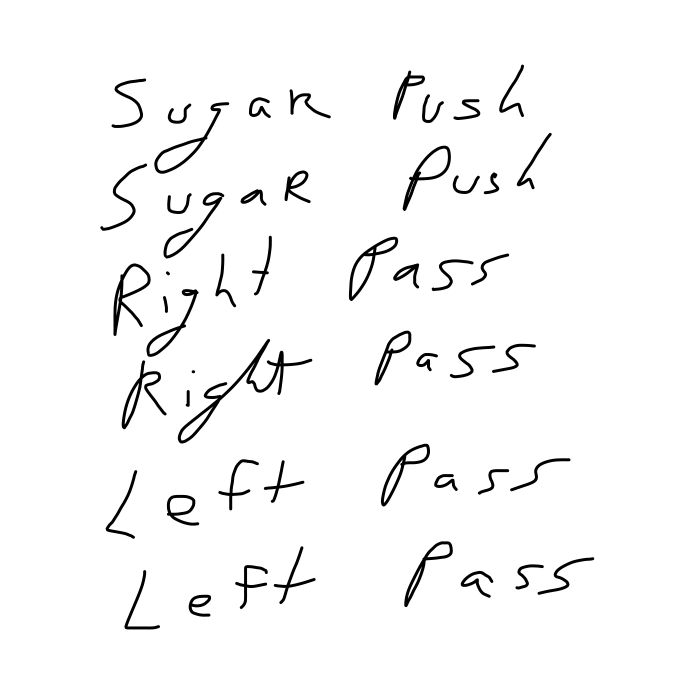Writing dance choreography and sequences
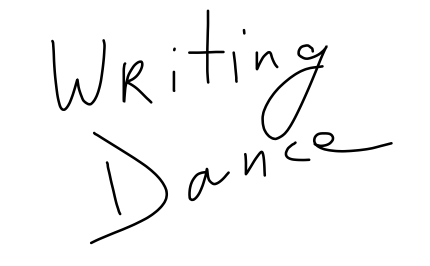 Writing down dance class choreography and sequences is one of the best ways to improve your dancing. I know it sounds crazy that writing could help one's dancing, especially in the day of video. As a teacher, I ask (and sometimes request - and sometimes even demand) that students write down the sequence of the day. I do this for the beginner, intermediate, and advanced classes. I do this because the act of writing helps the learning process.
Writing down dance class choreography and sequences is one of the best ways to improve your dancing. I know it sounds crazy that writing could help one's dancing, especially in the day of video. As a teacher, I ask (and sometimes request - and sometimes even demand) that students write down the sequence of the day. I do this for the beginner, intermediate, and advanced classes. I do this because the act of writing helps the learning process.
Why does writing help dancing?
This is your brain on dance
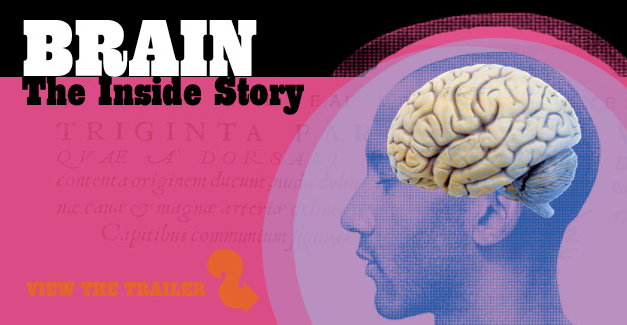 Good dancing is all about coordinated neurological activity. The challenge in a dance class - specifically, the first few dance classes - is that the brain is turning new verbal instructions into new synaptic connections which result in kinesthetic movement. It's not an easy feat and could be considered one of the "medium" types of learning (an example of "low" level learning would be learning not to touch fire, and "high" level learning might be understanding abstract ideas such as empathy, love or success). Although, there are some studies that show we are able to recognize rhythm as an infant, controlled usage of our body to such rhythms seems to still be a learned activity or ritual.
Good dancing is all about coordinated neurological activity. The challenge in a dance class - specifically, the first few dance classes - is that the brain is turning new verbal instructions into new synaptic connections which result in kinesthetic movement. It's not an easy feat and could be considered one of the "medium" types of learning (an example of "low" level learning would be learning not to touch fire, and "high" level learning might be understanding abstract ideas such as empathy, love or success). Although, there are some studies that show we are able to recognize rhythm as an infant, controlled usage of our body to such rhythms seems to still be a learned activity or ritual.
More information on how our brain is active while we dance can be found in my article about the Brain Exhibit at the Museum of Natural History.
Writing dance sequence enables your brain to actively process information through visual (seeing what we write), kinesthetic (writing what we write), and auditory (saying what we write) senses all at the same time. It allows your brain to create additional neural pathway to the information that you thought was just the physical form of dance.
How to write dance
I have seen many students who were willing to write down the sequence or choreography of the day...if only they knew how. This is your brain's way of saying that it doesn't have a neurological pathway to arrive at the destination. That's probably the problem with your dancing. If your brain can't process the information in multiple ways, then you probably don't fully understand the information. Here are some beginner to advanced examples of how to write a beginner West Coast Swing and Hustle class.
West Coast Swing sample notation
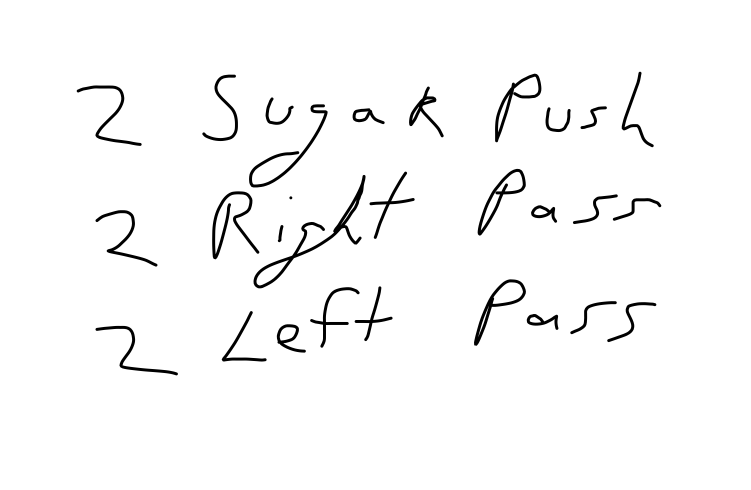 West Coast Swing Intermediate Notation |
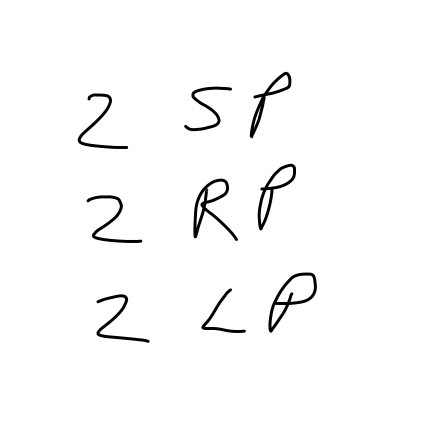 West Coast Swing Advance Notation (short-hand) |
Beginner Notation: Tends to write out the full name of the step or idea. This is ideal for a beginner student to someone struggling to remember the sequence. Any amount of detail can be added to this, such as the rhythm (walk, walk, cha-cha-chaa, cha-cha-chaa) or numeric value (1, 2, 3&4, 5&6). The sooner a student does this the quicker the overall kinesthetic learning process.
Intermediate Notation: This method already shows an abbreviation for the number of times something occurs while retaining the full imprint of the name of the pattern. This method is also good and can contain more detail as needed. Issues arise if there is any difference between the first Sugar Push and the second Sugar Push.
Advanced Notation: This short-hand approach to dance writing is great once names of patterns and their rhythms and structures are already mentally coordinated. This notation is best suited to remember a sequence. It requires that many linguistic, kinesthetic, rhythmic assignments/coding (aka "chunking"). This method is not as helpful to a newcomer, since "SP" would have to assigned the meaning of "Suger Push" prior to the notation process.
Hustle sample notation
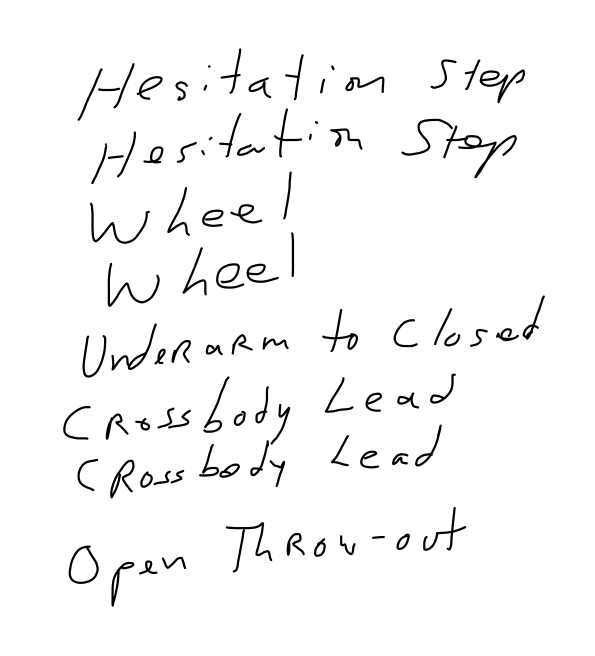 Hustle Beginner Notation |
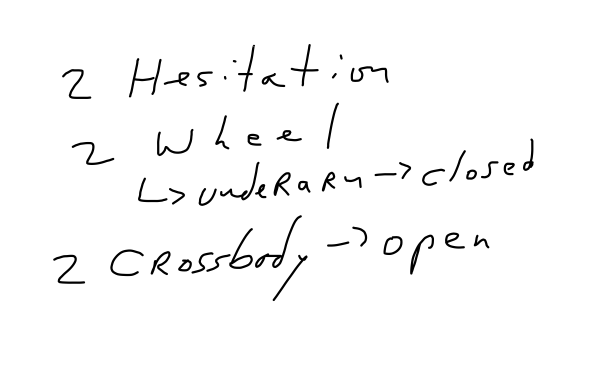 Hustle Intermediate Notation |
Beginner Notation: As in the West Coast Swing notation above, beginner Hustle notation writes out the full name of the step or idea. This is ideal for a beginner student to someone struggling to remember the sequence. Any amount of detail can be added to this, such as the rhythm (quick-quick, slow-slow) or numeric value (&1, 2, 3). The sooner a student does this the quicker the overall kinesthetic learning process.
Intermediate Notation: Similarly, intermediate Hustle Notation consolidated the movements into smaller groupings ("chunks") and is able to use arrows to express different ending positions.
Writing is individualistic
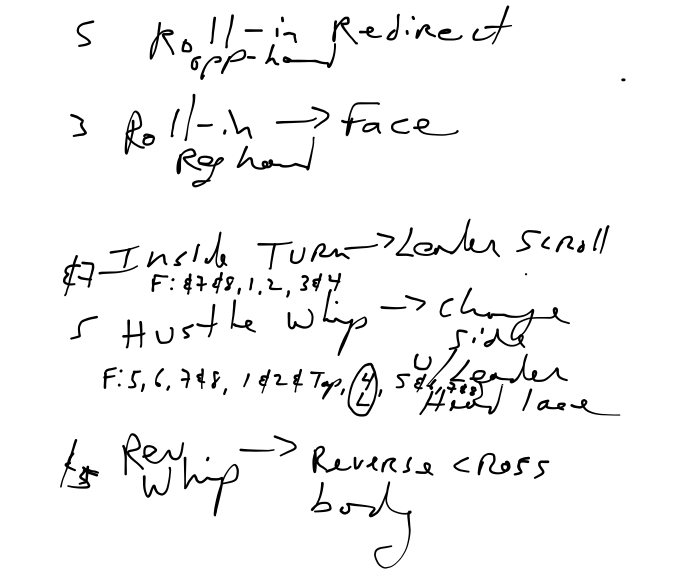 One of the beauties of writing choreography or dance sequences is that it is custom tailored to the person who is writing it. If carefully analysed, it is a window into how our mind processes information. Do you write the "name" of the move/pattern, do you write the rhythm or which leg moves? Many people use combinations of all of these ideas to notate the information which they are processing.
One of the beauties of writing choreography or dance sequences is that it is custom tailored to the person who is writing it. If carefully analysed, it is a window into how our mind processes information. Do you write the "name" of the move/pattern, do you write the rhythm or which leg moves? Many people use combinations of all of these ideas to notate the information which they are processing.
I have many ways of writing down class choreography for myself so that I can remember movements, specific numeric values for complicated steps and even lyrics which are supposed to be highlighted through movement.
Should the teacher give a "hand out" of the class?
Many students have asked me for my notes. As much as I don't mind helping the notations process, it is important that students realize that the act of recalling and expressing movement in a written form will exponentially increase their awareness of their physical movement.
The best part about writing dance sequences is that it facilitates long-term learning by giving the brain multiple ways to process information. If I give my notes away, it does not actually help the student, it just gives them a crutch. However, I don't mind if a student uses my notes to create their own notes in their own language.
When to use video
Video is possibly the greatest tool ever invented for dance choreography. Archiving movement has been a dilemma for choreographers for as long as dance has existed. Dance notation is probably not the best way to archive choreographic works for the long term. It is, however, one of the best ways to augment and accelerate one's learning of dance. As a teacher, choreographer and student, I still write my notes (both by hand or on the computer) so that I am able to examine, recall and analyze my work.
